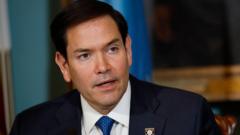The National Institutes of Health (NIH) has announced the slashing of billions from biomedical research grants, specifically targeting indirect costs. While the administration claims this will enhance efficiency, scientists warn that such cuts could severely hinder medical advancements and curtail crucial research capacities.
Trump's Biomedical Research Funding Cuts Spark Outcry Among Scientists

Trump's Biomedical Research Funding Cuts Spark Outcry Among Scientists
The Trump administration's recent decision to reduce overhead funding for biomedical research grants raises alarms about potential setbacks in scientific innovation.
The Trump administration has unveiled a controversial plan to cut billions from overheads in biomedical research grants, prompting a strong backlash from the scientific community. In an announcement made by the National Institutes of Health (NIH) on Friday, officials stated their intention to significantly reduce funding allocated for "indirect costs" associated with research, which encompasses expenses related to infrastructure, utilities, and equipment.
According to the NIH, the decision aims to ensure that a greater portion of research funds is dedicated to direct scientific inquiry. The agency estimates these cuts, which will take effect starting Monday, could lead to a savings of $4 billion. The cap for indirect costs tied to grants will be limited to 15 percent, a substantial drop from the current average of 30 percent.
Elon Musk, who heads the new Department of Government Efficiency (Doge), has asserted that some universities have been misappropriating funds, claiming they have charged as much as 60 percent in overhead on research grants. "Can you believe that universities with tens of billions in endowments were siphoning off 60% of research award money for 'overhead'?" Musk remarked on social media platform X, labeling the practice a "ripoff."
Despite these justifications, many scientists have expressed deep concerns over the negative repercussions this funding cut may have on pivotal medical research. The Association of American Medical Colleges (AAMC) stressed that federal support for indirect costs is essential for sustaining medical research efforts. They warned that the new policy could weaken the nation’s research capabilities, subsequently slowing down scientific advancements and leaving patients and communities without access to new treatment options.
Stanford University's Dr. Anusha Kalbasi described the administration's cuts as a "disaster beyond belief," emphasizing the importance of funding for basic operational necessities within research institutions. "Who pays the electricity, rent, water, and admin staff facilities?" Kalbasi questioned.
Meanwhile, the American Council on Education acknowledged that funding for indirect costs enables universities to maintain advanced laboratories and technologies that outpace international competition. In a conversation with the Washington Post, the organization’s president, Ted Mitchell, reported that several labs had begun shutting down operations over the weekend in anticipation of the impending funding cuts. Legal action against the administration is also being considered in response to these significant changes.
The initiative to impose caps on indirect research grant funding has its origins in Project 2025, a compilation of conservative policy goals formed by the Heritage Foundation think tank, which advocates for limiting federal funding routes to align closer with private sector standards.





















